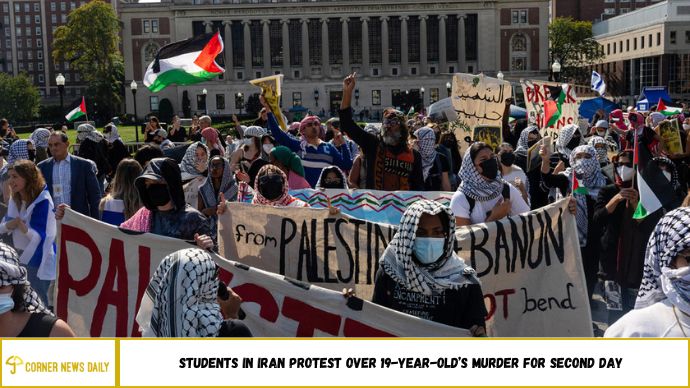Students in Iran have continued to protest following the tragic death of 19-year-old Amir Mohammad Khaleghi, a business student at Tehran University, who was killed during a robbery on campus last week. Khaleghi was fatally attacked by two robbers near a university dormitory on Wednesday, sparking widespread outrage and protests starting Friday.
The protests have intensified as demonstrators accuse university officials of failing to ensure student safety on campus. As protests escalated, clashes occurred between students and police near the dormitory where Khaleghi was murdered. The student died later in the hospital from his injuries.
Protesters have been vocal in their anger, chanting phrases such as “Shame on you!” and “University security is a tool of the IRGC, you are our murderers!” They also shouted, “The blood that has been spilled can never be erased!” in reference to the senseless loss of life.
In response to the public outcry, Iran’s vice president, Mohammad Reza Aref, ordered an immediate investigation into Khaleghi’s death. However, Iranian authorities have also issued stern warnings to protesters. Hossein Sarraf, Iran’s Minister of Science, Research, and Technology, cautioned that university-related issues should not spill over into broader political matters, threatening severe consequences for those protesting outside the campuses.
While the protests themselves are not politically driven, demonstrations in Iran often have the potential to escalate into political unrest, particularly in a country with such a strict regime. The growing discontent reflects the frustration of students with both the safety conditions on campus and the lack of accountability from university authorities.

The Tragic Death that Sparked the Protests
On the heels of a deeply tragic event, students in Iran have been organizing protests over the killing of 19-year-old student Peyman Heidari, who was found murdered on a university campus. Heidari’s death has sparked widespread outrage, especially among students, who see this as a symptom of a larger issue of violence on campuses and lack of justice.
- The Incident: Heidari was found dead under suspicious circumstances, and the details surrounding his murder have raised serious concerns. Many students believe that the act was politically motivated or linked to broader societal tensions.
- Student Response: In protest, students have gathered for marches and demonstrations, calling for justice for Heidari. These protests have quickly spread, turning into a broader statement against violence and the government’s handling of such incidents.
The Growing Movement
This protest is not an isolated event. It is part of a larger wave of student activism in Iran, which has grown in recent years. Students, who have long been seen as key figures in pushing for change, are taking to the streets in increasing numbers, demanding freedom of expression and political reform.
- Protests’ Key Demands: While justice for Heidari is at the forefront, the demonstrations have also raised issues such as freedom of speech, academic autonomy, and the right to protest without fear of retribution.
- Nationwide Spread: What started as a campus protest in one city has quickly spread to other universities across the nation, signaling a nationwide call for action.
Challenges Faced by Protestors
While the protests have been significant, government crackdowns are always a concern. Iranian authorities have a history of suppressing dissent, especially when it involves students and youth. Protestors face the threat of arrests, violence, and intimidation, but the resolve to seek justice remains strong.
- Government Response: In the past, such protests have often been met with harsh repression, including violent clashes and military intervention. However, the increasing visibility of these protests, both within Iran and globally, may affect how the government responds this time.
- International Attention: The protests have drawn the attention of global human rights organizations and the international community, who have condemned the violence and urged the Iranian government to address the grievances of the students.
The Impact on Iranian Society
The death of Peyman Heidari and the subsequent protests serve as a reminder of the growing frustration among Iran’s younger generation, particularly students, who feel disenfranchised and silenced by the government. The protests highlight deep-rooted societal issues that continue to simmer beneath the surface, from political repression to systemic violence and gender inequality.
- A Young Generation Seeking Change: The students protesting are part of a younger generation that has grown up in a rapidly changing world. Their demands for justice are intertwined with their desire for a more open, democratic society where they can voice their opinions without fear.
- Future of Protests in Iran: With students leading the charge, the protests could represent a turning point in Iran’s political landscape. The continued unrest may push the government to address the broader social and political demands of the youth.
Conclusion
As protests continue for a second day, the tragic murder of Peyman Heidari has sparked a larger conversation about the state of free speech, student rights, and violence on campuses in Iran. With increasing numbers of students and activists taking a stand, the movement may well set the stage for broader social change in the country.
FAQs:
What sparked the student protests in Iran?
The protests were sparked by the murder of 19-year-old student Peyman Heidari on a university campus.
Why are students protesting?
Students are protesting to demand justice for Heidari and to raise awareness about political repression, violence on campuses, and human rights violations.
What are the demands of the protestors?
Protestors are demanding justice for Heidari, greater political freedoms, academic autonomy, and an end to violence against students.
How has the Iranian government responded to the protests?
The government has responded with crackdowns, and protests face the threat of violent suppression and arrests.
Are the protests gaining international attention?
Yes, human rights organizations and global leaders have condemned the violence and are calling for justice in Iran.
What is the future of student activism in Iran?
The protests signify a growing movement among students for democratic reforms and greater freedom in the country.

